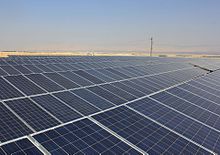Renewable energy in Palestine is a small but significant component of the national energy mix, accounting for 1.4% of energy produced in 2012.[1] Palestine has some of the highest rate of solar water heating in the region,[2] and there are a number of solar power projects. A number of issues confront renewable energy development; a lack of national infrastructure and the limited regulatory framework of the Oslo Accords are both barriers to investment.

Solar power
editIt has been estimated that solar sources have the potential to account for 13% of energy usage in the Palestinian Territories.[3] Over half of all households in Palestine utilise solar energy heaters, although only 3% of houses depend on it as their main source.[4] A 710kw photovoltaic plant was commissioned in September, 2014 in the vicinity of Jericho; it is the largest plant in Palestine to date.[5] Research has indicated that, although a very high percentage of Palestinian houses are connected to the central grid, powering remote villages with small-scale photovoltaic systems would be more economically feasible than extending the grid.[6]
Israeli authorities seized a solar/diesel hybrid electric system from the Palestinian village of Jubbet ad-Dib in July, 2017.[7] The system was funded by the Dutch government and installed by joint Israeli-Palestinian organisation Comet-ME, leading the Dutch Foreign Ministry to lodge a complaint. The Coordinator of Government Activities in the Territories told reporters that the solar panels were erected “without the necessary permits, and that stop work orders had previously been sent to the village authorities,”[8] although a Haaretz report indicated that the confiscation orders were only delivered during the raid, meaning there was no chance to contest them in court.[9] Residents of the village, located in Area C between a number of Israeli settlements, had been attempting to implement and gain approval for solar power projects since 2009.[10]
Wind power
editIt has been estimated that wind energy has the potential to account for 6.6% of energy usage in the Palestinian Territories.[3]
Biomass
editAbout half of the Palestinian population - mainly in the rural areas, refugee camps, and Bedouins of North and South Governorates - are exposed daily to harmful emissions and other health risks from biomass burning that typically takes place in traditional stoves without adequate ventilation. The majority of individuals exposed to enhanced concentrations of pollutants are women and young children.[11]
National policy
editThe Palestinian Energy Authority (PEA) published a 'General Renewable Energy Strategy' in 2012, aiming for 10% of total domestic energy production and 5% of total energy consumption to come from renewable sources by 2020.[12]
Barriers
editThere are a number of barriers to development of renewable energy resources in Palestine, including regulatory issues resulting from the Israeli occupation,[13] and this meant the government was unable to achieve its target of 25 megawatts by 2015. However, renewable energy has a large potential to reduce reliance on imported energy and address a number of social issues.[1]
References
edit- ^ a b Ziad Yamin, Mohammad. "Renewable Energy in Palestine". EcoMENA Echoing Sustainability. Retrieved 6 June 2017.
- ^ "Arab States and Sustainable Energy Capabilities: Brief Profiles on Thirteen Countries' Promising Renewable Energy and Energy Efficiency Markets". Regional Center for Renewable Energy and Energy Efficiency. Retrieved 6 June 2017.
- ^ a b Abu Hamad, Tareq (January 2012). "Renewable energy in the Palestinian Territories: Opportunities and challenges". Renewable and Sustainable Energy Reviews. 16 (1): 1082–1088. doi:10.1016/j.rser.2011.10.011.
- ^ "Press Release on Results of Household Energy Survey (January 2015)". Palestinian Central Bureau of Statistics (PCBS) - State of Palestine. Retrieved 4 June 2017.
- ^ "No trumpets – solar power for Jericho and its neighbours instead. In the vicinity of the lowest city in the world one of the largest solar power stations in the Middle East produces clean electricity with inverters by KACO new energy". KAKO. Retrieved 31 May 2017.
- ^ Mahmoud, Marwan (2006). "Techno-economic feasibility of energy supply of remote villages in Palestine by PV-systems, diesel generators and electric grid". Renewable and Sustainable Energy Reviews. 10 (2): 128–138. doi:10.1016/j.rser.2004.09.001.
- ^ McKernan, Bethan. "Israel seizes solar panels donated to Palestinians by Dutch government". Retrieved 5 July 2017.
- ^ "Israel dismantles Palestinian solar project in West Bank". Retrieved 5 July 2017.
- ^ Hass, Amira. "Dutch protest Israeli seizure of Palestinian solar panels they funded in the West Bank". Retrieved 5 July 2017.
- ^ O'Connor, Anne-Marie. "20 minutes from modern Jerusalem, a Palestinian village is stranded in the past". Retrieved 5 July 2017.
- ^ Abu-Madi, Maher; Abu Rayyan, Ma’moun (2013). "Estimation of main greenhouse gases emission from household energy consumption in the West Bank, Palestine". Environmental Pollution. 179: 250–257. doi:10.1016/j.envpol.2013.04.022. PMID 23694729.
- ^ "A Socio-Economic Analysis of Renewable Energy Usage in Palestine". Heinrich-Böll-Stiftung. Retrieved 6 June 2017.
- ^ Marei, Ibrahim (2017). "Developments in Law and Policy: The Promotion of Green Energy in the Electricity Sector of Palestine" (PDF). Journal of Energy & Natural Resources Law. 35 (1): 47–67. doi:10.1080/02646811.2016.1216698.
External links
editMedia related to Renewable energy in Palestine at Wikimedia Commons